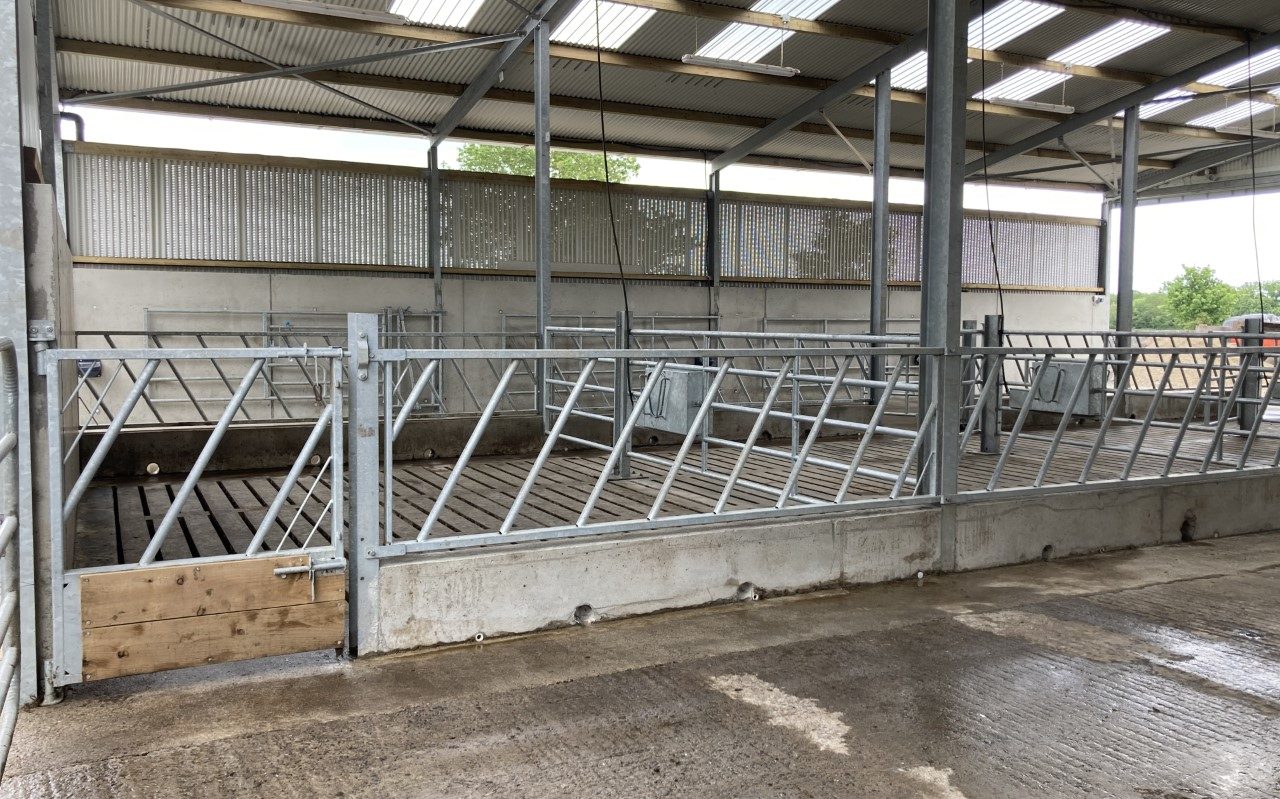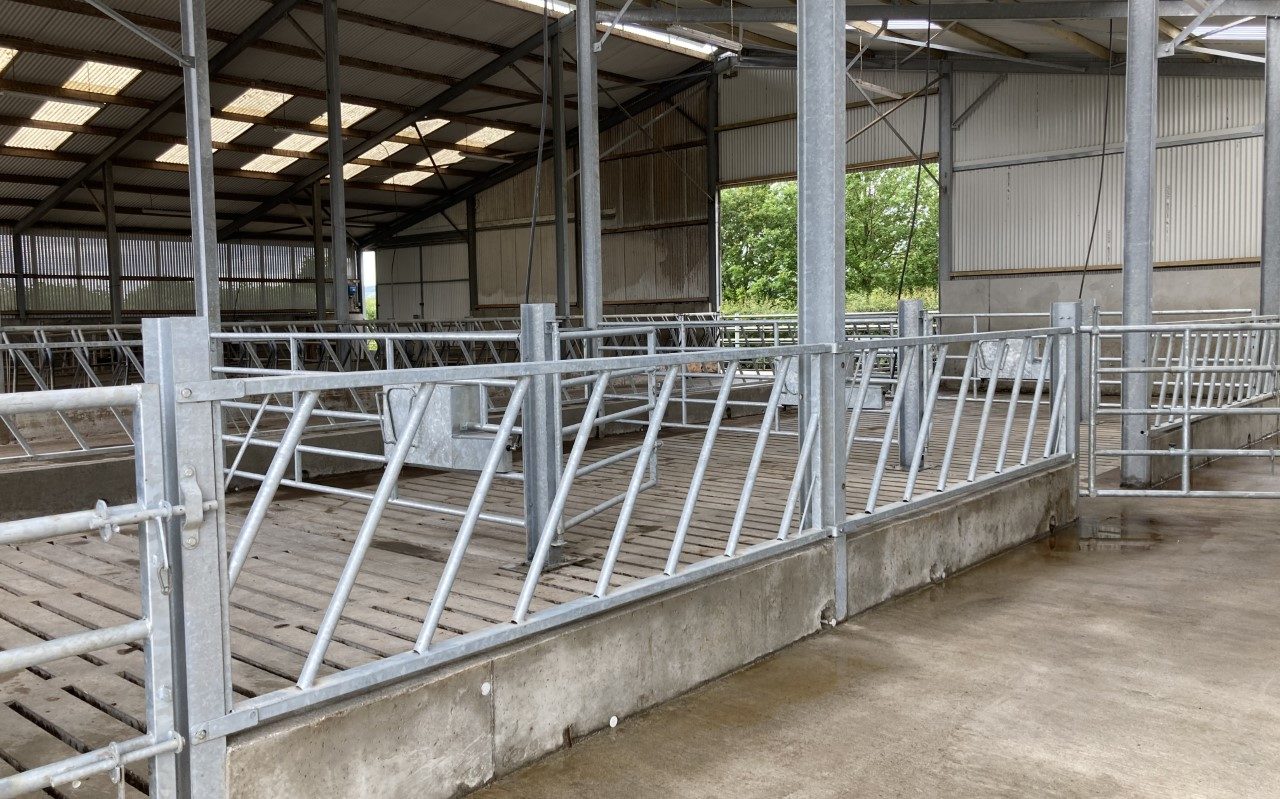For this week’s Buildings Focus, Agriland made the trip to Co. Tipperary to check out a new suckler unit on the farm of Robin Harold Barry.
The suckler farmer, from Bansha, also runs an agricultural contracting business as well as selling, fixing and servicing trailers – a new venture that took-off three years ago.
Farming alongside his sons, Robin operates a spring-calving system that sees him calve-down a mixture of 55 Limousin, Angus, Charolais and Hereford cows.
The bull calves are kept and sold as steers at roughly 12 months-of-age and the heifers are kept until 16 months-of-age and then sold – except for a handful which are kept as replacements.

Speaking about building a new suckler shed, which joins-up with an existing suckler unit and is basically a carbon copy of it, Robin said: “I had enough housing here for the cows, but I didn’t have room for my weanlings.
“So basically, I was renting sheds out the last few years to house the weanlings and the winter gone by, I was actually outwintering some of my cattle.
“I had always planned to build more housing, but as the saying goes ‘Rome wasn’t built in a day’ – it was the same for me, I had to wait and eventually last year we got the chance to get the shed up.”

Suckler unit layout
From the offset, Robin wanted to build on from his existing shed that was built not far off 20 years ago.
The original shed consisted of four double-slatted pens, with calving/creep pens behind them and a crush then hugging the back wall.
Robin wanted the same thing in the new shed, except for a crush. The digging out of the site and all the concrete work, including the tanks, was carried out by Kevin Byron.
While the shed itself was sourced and erected by O’Dwyer Steel – who actually erected the existing shed as well.
Looking at the layout of the new shed, it measures 16.1m wide and 19.1m long. The shed stands 7.43m high to the apex and 4.5m high to the eave gutters.

The slatted pens are 6.2m long and range in different widths from 4.7m to 4.8m.
The calving/creep pens are 4.18m long. The walls of the shed stand 2.45m high.
There was an existing concrete-floored feeding passageway, so all that had to be done there, was to put a roof over it.
Robin now has the ability to hold up to 110-115 head of cattle between the old and new shed together.

A closer look at the new unit
Taking a closer look at the new unit, it contains four slatted pens – which Robin says have the capacity to hold 15 weanlings.
The main reason why it can take that many is due to the fact that there is feeding space at opposite ends of the pen.
If that wasn’t the case, Robin would end up only being able to accommodate seven or eight weanlings – depending on size.



Even though the new unit was used to house weanlings this winter gone by, Robin made sure to leave his options open, by putting in creep gates at the back of the pens leading into the back-feeding passway, that can also act as a calving/creep area.

A very useful feature of the shed is the slope incorporated from the feeding passageway and the creep/calving pens, into the new slatted tank.
It allows any effluent from the silage or faeces from the calving/creep pens to drain away from both areas.
Circular incisions in the concrete (pictured below) were made for effluent/faeces to drain from these areas into the tank.

Creating further calving space
Despite having calving pens in the original shed, Robin said you can’t have enough – especially when calving down a substantial number of cows.
He added: “We calved down 55 cows there this year and the extra four calving pens in the shed were invaluable.
“I tend to not leave the bull in too long with the cows – I strive for a compact calving season and because of that, cows end up calving thick and fast.


“So the extra few pens were a real bonus. At the back of the shed, there’s a runway that runs from the back of the calving pens in the old shed, down to the calving pens in the [new] shed.
“So if all the pens are occupied in the original calving pens, I can move a cow close to calving from the slatted pens, out the side door, down to the calving pens in the new shed.
“Having the extra pens takes the stress away if the pens in the old shed are full, and the fact the runway is there to connect the two sheds, it makes it easy for one person to move a cow out from the slats and put her in a pen on her own if she’s close to calving.”

The importance of good ventilation
Robin said that having good ventilation is key in any type of animal housing, but that when you have over 100 cattle in one shed – the importance of getting it right is critical.
He added: “Previously, when we just had the four-bay shed, because it was open at the front, there was no issue with airflow circulating through the shed.
“But when we added the extension last year and when you add all the weanlings into the equation, on top of the cows, the flow air around the shed isn’t what it once was.
“So that’s why we have plenty of sliding doors, six in fact, throughout the shed, as well as gaps between the roof and the sheeting – to allow air in.
“It’s vital to keep the shed well-aerated or else you’re going to run into trouble and thankfully, we have avoided that issue of having a stuffy shed.”



Existing suckler unit
The existing suckler shed, which was also erected by O’Dywer Steel, has been in use for 17 years, and only at really close inspection would you realise it wasn’t put up at the same time as the new extension – which is a really good sign of a well-built and kept shed.



The existing shed was used to house the herd of cows and continues to do so. It is laid out pretty much the same as the new part of the shed, except for it contains two tanks and has a crush at the back wall.

A small door at the back of the shed leads out a small outdoor creep space that calves have access to.
Robin says it’s a great way of not only giving calves a taste of the outdoors, but also because there is electric fencing around the boundary of it – which calves are able to get used to before being put out to grass.
This outdoor creep area is bedded with wood shavings, and Robins says it would last the entire calving season without having to be changed.

Dungstead
Along with building the new suckler unit, directly behind it outside, is a dungstead.
Robin added: “We had originally thought about making it bigger, but for the amount of farmyard manure we would have, it didn’t make sense, so even though it’s a fair size, it’s still a good bit smaller than what was originally planned.”

Cost
Robin applied for a grant and was eligible for 40% under the Targeted Agricultural Modernisation Scheme (TAMS II).
The overall cost of the new suckler unit and the dungstead came to €75,000 (including VAT).

Speaking about his decision to go back and build the new unit, Robin said: “It just came to a stage where I just had to go and do it.
“I am very happy with how it turned out. It wasn’t sustainable what we were doing and outwintering cattle was a pure and utter disaster – between ripping the ground up and the cost of reseeding it – you couldn’t keep doing it.
“It’s great now that when we go to house cattle in the winter, we know we can fit all now into the shed.
“As well before that, when we were renting sheds, it used to take up to an hour and a half to bring silage over to the sheds and because it was so far, the cattle would end up not getting fresh silage as often as we would have liked.
“So now that we will have them all outside our doorstep, that’s another problem that won’t exist anymore.
“Lastly, I have to give credit to Kevin Byron and O’Dwyer Steel for the quality of the work they did – I told them what I wanted and they just came in and did exactly that,” Robin concluded.

